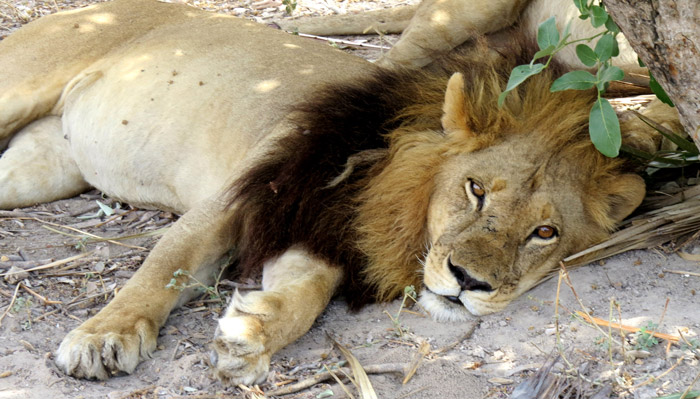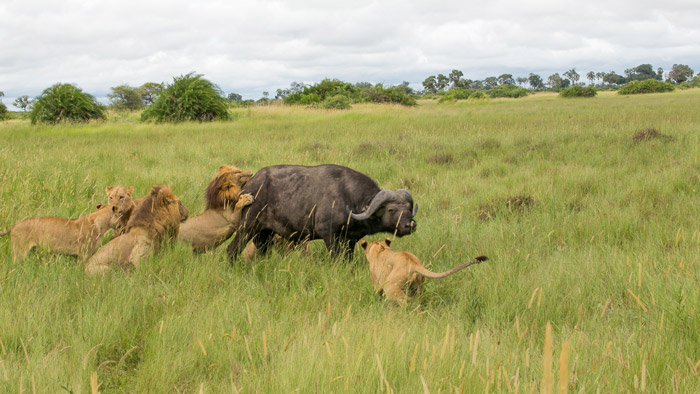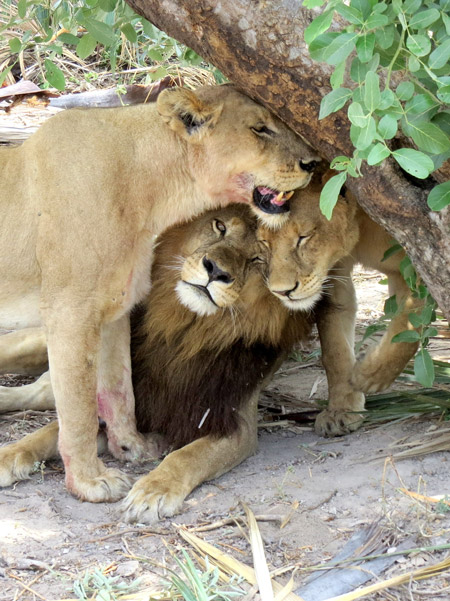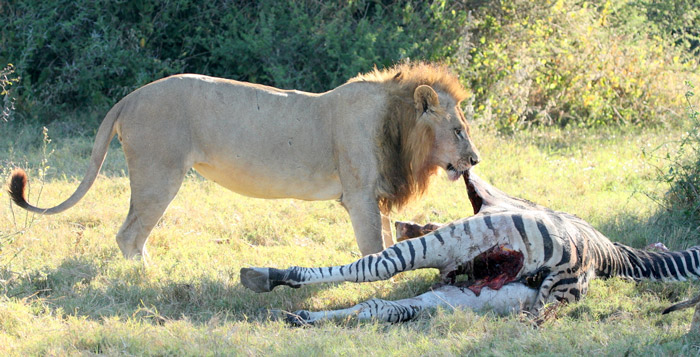We had been at Mombo for nearly a week when we heard the call over the radio – the Western Pride had been located. This was significant for me because I am trying to create identification cards for all the lions on the Mombo concession for monitoring, but mostly because I am intrigued about Mmamoriri. As we drive into the sighting, one of the guides points her out. Lazing under the shade of a rain tree with her pride members is a maned lioness with a full black mane. Written by: Robynne Kotzee

Mmamoriri is not the first of the Western Pride to sport a mane, nor is she the only maned lioness on Chief’s Island in the Okavango Delta, Botswana. Martina, her predecessor, was regularly sighted around Mombo, and while her mane was much blonder, it was equally impressive. Recently, in a more southern pride on the concession, another young maned lioness has been spotted flaunting the first few tufts of a maturing mane. While this is not the norm, there has been an increase in reported incidences of these unusual felines on and around Chief’s Island over the last few years.


Later in the afternoon, the entire Western Pride came together to rest in the centre of the island, where they were located earlier in the day by guides at Mombo Camp. Here, we had a good chance to gauge her size and compare her features to the rest of the females in the pride and the pride male.
In an attempt to discover the reasons behind this anomaly, Simon Dures, while conducting his PhD research on the genetic diversity of lion populations in northern Botswana, took blood samples from Mmamoriri to conduct genetic and hormone tests. While the research, in association with the Zoological Society of London and Imperial College London, is still ongoing, initial testing has started to unravel the mystery. Molecular testing aimed at examining chromosomes – the genetic material which determines sex – has revealed that Mmamoriri is genetically a female, despite her masculine features. This rules out at least one of the theories that she may have possessed an extra Y-chromosome (usually unique to males) that would have led to her ambiguous sex characteristics.
So what is it that led to Mmamoriri’s unusual appearance?
“Due to the location of the maned females, the prevalence of the condition and the symptoms, it is unlikely not to be a genetic trait – but this still needs to be confirmed,” Simon adds. Given what we know now, it seems quite likely that Mmamoriri’s condition developed in the womb. Certain genetic conditions may result in the exposure of the foetus to excess androgens, which could result in the development of male sex characteristics in females. In the lion’s case, this may be a mane and a slightly larger body size.
While this condition is well-documented in humans, it is quite uncommon in the animal kingdom.
What does this trait’s propagation mean for the Okavango lions?
“Implications of the trait are limited due to the current low prevalence, but if the trait is recessive, and with the number of incidences appearing to increase, this could change. She (Mmamoriri) appears infertile and, if this is true, any lions with the condition are essentially removed from the gene pool, reducing the breeding population, and thus increasing the risk of population decline,” Simon states.

Simon’s data analysis has further revealed that genetically, the lions of the Okavango Delta are more isolated than lions from elsewhere in northern Botswana. This means that there has been somewhat limited movement of genetic material between the Okavango and surrounding conservation areas. This type of isolation over time may cause certain genetic traits, such as the maned lioness Mmamoriri’s, to increase in frequency.
Escalating human-carnivore conflict on the edges of protected areas, where lions are killed in retaliation for predating on cattle, is one factor that may limit genetic flow both to and from the Okavango. Young male lions, whose dispersal is the key to gene flow between different populations, are particularly vulnerable, as they often turn to prey on cattle during this stage of their lives.
Another factor which may be relevant, particularly on the northern section of Chief’s Island, where the trait keeps surfacing, is swelling water levels. Over the past decade, an increase in flood regime has caused the Mombo concession to become increasingly isolated as swamps surrounding the island have expanded and have remained flooded for longer. While this is not an impenetrable barrier to movement, it may deter young, inexperienced male dispersers from leaving the island to cross seemingly endless and unfamiliar swamps.

While the trait is something of a marvel and does not as yet pose a significant threat to the lions of the Delta, it is a reminder that on a larger scale, we need to ensure genetic flow between increasingly isolated populations of species such as the lion. Corridors linking sub-populations need to be maintained and, if lost, restored to allow for the natural dispersal of such wide-ranging predators.

By the time we reached the Western Pride it was late afternoon, and they had congregated in the shade in the middle of the island. The pride male is there, and I notice that while bigger than the other females, Mmamoriri is still noticeably smaller than him and does not share the same bulk and broader face typical of mature males. Nevertheless, seeing such an exquisite and unique maned lioness while on safari is a wonder.

READ about Botswana as a safari destination
To comment on this story: Login (or sign up) to our app here - it's a troll-free safe place 🙂.![]()






